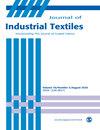Mechanical and thermal characterization of resin-infused cotton fabric/epoxy composites: Influence of woven construction parameters and surface treatments
IF 2
4区 工程技术
Q1 MATERIALS SCIENCE, TEXTILES
引用次数: 0
Abstract
This study explores the mechanical and thermal characterization of epoxy-based composites reinforced with chemically modified woven cotton fabrics using the resin infusion technique. The woven fabrics construction parameters were varied in terms of weft yarn counts (16, 20, and 24 Tex) and pick densities as defined by pick wheel teeth (PWT) (30, 36, and 41 T). The fabrics were surface treated with 6% concentration of sodium hydroxide (NaOH) using the alkali treatment method. The obtained results revealed that mechanical strength improved with decreasing weft yarn count and increasing PWT. Notably, chemically treated composites with the highest PWT exhibited superior strength compared to untreated counterparts, attributed to more compact microstructures, reduced fabric/fiber breakages, and enhanced interfacial bonding between the reinforced plain-woven cotton fabric and epoxy matrix. Thermogravimetric analysis (TGA) showed that all composites have higher thermal stability above 300°C, with untreated fabric composites exhibiting the highest resistance to degradation, whereas the treated composite quickly degraded at an onset temperature of 288.4°C due to the removal of the hemicellulose, decomposition of the cellulose, and lignin content. In conclusion, the study indicates that surface treatment and woven construction parameters such as weft yarn counts and pick wheel teeth, as well as the resin infusion technique, significantly influence the mechanical, microstructural, and thermal properties of resin-infused woven cotton reinforced composites for potential application in industrial and automotive sectors, offering lightweight, durable solutions for components such as construction and building panels, doors, and roof panels.树脂注入棉织物/环氧树脂复合材料的力学和热学特性:编织结构参数和表面处理的影响
本研究采用树脂灌注技术,探讨了化学改性棉织物增强环氧基复合材料的机械和热特性。编织物的结构参数在纬纱支数(16、20 和 24 Tex)和挑轮齿密度(PWT)(30、36 和 41 T)方面有所不同。采用碱处理法,用 6% 浓度的氢氧化钠(NaOH)对织物进行表面处理。结果表明,机械强度随着纬纱支数的减少和 PWT 的增加而提高。值得注意的是,与未经处理的同类产品相比,经过化学处理的复合材料具有最高的 PWT,表现出更高的强度,这归功于更紧凑的微结构、更少的织物/纤维断裂以及增强平纹棉织物与环氧树脂基体之间更强的界面粘合力。热重分析(TGA)显示,所有复合材料在 300°C 以上都具有更高的热稳定性,其中未经处理的织物复合材料表现出最高的抗降解性,而经过处理的复合材料由于半纤维素的去除、纤维素的分解和木质素含量的增加,在 288.4°C 的起始温度下迅速降解。总之,该研究表明,表面处理和编织结构参数(如纬纱支数和挑轮齿数)以及树脂灌注技术会显著影响树脂灌注棉编织增强复合材料的机械、微观结构和热性能,从而为工业和汽车行业提供轻质、耐用的部件解决方案。
本文章由计算机程序翻译,如有差异,请以英文原文为准。
求助全文
约1分钟内获得全文
求助全文
来源期刊

Journal of Industrial Textiles
MATERIALS SCIENCE, TEXTILES-
CiteScore
5.30
自引率
18.80%
发文量
165
审稿时长
2.3 months
期刊介绍:
The Journal of Industrial Textiles is the only peer reviewed journal devoted exclusively to technology, processing, methodology, modelling and applications in technical textiles, nonwovens, coated and laminated fabrics, textile composites and nanofibers.
 求助内容:
求助内容: 应助结果提醒方式:
应助结果提醒方式:


